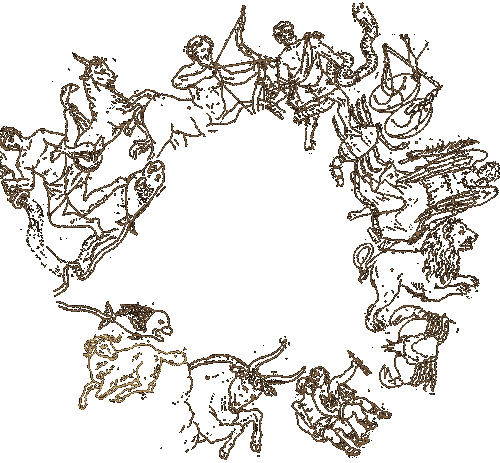




Aries was seen as a ram for at least 3,000 years. Since it was beginning of the
zodiac i.e. the location of the vernal equinox in around 1000 BC, it was also called
the 'prince of constellations'.
In ancient Egypt ram gods were always seen as powerful and important, one of the
most remarkable was Chnum who made the Nile delta fertile and created the human by
forming unborn children from clay. He was told to be the first god, builder of man
and creator of gods, the Father who was in the beginning of it all, the "raiser
of heaven upon its four pillars".
Banebdjetet is another Egyptian ram god, the consort of the fish goddess Hatmehit.
Seeing the Ram and the Fish standing side to side in the zodiac, it is easy to
imagine that at least their worshippers in the Nile delta saw both constellations as
the starry images of the divine couple.
Considering the location of Aries next to the area of the seas in the zodiac, one
should also remember Heryshaf, a ram god of Middle Egypt who was born from the
waters that once covered the whole world. His name translates as 'He who is upon his
lake', and he was identified with Osiris and Re.
 The
Greek didn't worship the ram as much, although one of the first Greek legends
adressing Aries said that it was Zeus himself who transformed into a ram with a
golden fleece to escape hostile giants.
The
Greek didn't worship the ram as much, although one of the first Greek legends
adressing Aries said that it was Zeus himself who transformed into a ram with a
golden fleece to escape hostile giants.
 More popular became the Greek
legend of the ram with the golden fleece which was sent by Hermes to carry a prince
and his princess across the Hellespont. The princess fell off the ram and was
killed, and the ram then told the prince to sacrifice him to the gods. The golden
fleece was taken and kept in Colchis, and the most famous part of the story told
when Iason and the Argonauts wrested the golden fleece from the guarding dragon with
the help of Iason's bride Medea.
More popular became the Greek
legend of the ram with the golden fleece which was sent by Hermes to carry a prince
and his princess across the Hellespont. The princess fell off the ram and was
killed, and the ram then told the prince to sacrifice him to the gods. The golden
fleece was taken and kept in Colchis, and the most famous part of the story told
when Iason and the Argonauts wrested the golden fleece from the guarding dragon with
the help of Iason's bride Medea.

